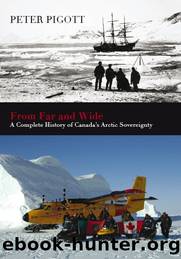From Far and Wide by Peter Pigott

Author:Peter Pigott [Pigott, Peter]
Language: eng
Format: epub
Tags: History, Canada, General, Military, Polar Regions, Expeditions & Discoveries
ISBN: 9781554889877
Google: 1nMRR3nzAnQC
Publisher: Dundurn
Published: 2011-11-16T04:56:36+00:00
With the pilotâs worst enemy â the Arctic weather â some 30 meteorological stations were built by the U.S. military through the eastern Arctic. Late in September 1941, the U.S. Naval Reserve transported three small detachments to set up meteorological stations and airfields at Fort Chimo (CRYSTAL 1), Frobisher Bay (CRYSTAL 2), and Padloping Island (CRYSTAL 3). The CRYSTAL stations were manned by the U.S. military, but Canada retained the right to their use when the war ended.
When Germany invaded the USSR on June 22, 1941, concern over a Japanese attack on Alaska was heightened and the U.S. Secretary of War Henry L. Stimson (who had in 1931 had promulgated the âStimson Doctrineâ on non-recognition of territorial changes in wartime) said that a highway to Alaska had to be built immediately. But even in October 1941, King was still reluctant to invest time and money in a road, stating that he preferred to develop the NWSR.
The reports on December 8 that eight of the nine battleships of the U.S. Pacific fleet at Pearl Harbor had been sunk or were immobilized stunned King and for the first time the prime minister feared a Japanese attack on British Columbia. He also knew that all there was to protect the British Columbia coastline was the âFishermanâs Reserveâ â a home guard of 17 fishing vessels and 150 officers and men drawn from the local fishing community. Possibly because Ian Alistair Mackenzie, the Member of Parliament for Vancouver Centre, had been the minister for national defence from 1935â39, the RCAF squadron based at Sea Island had managed to supplement its obsolete Blackburn torpedo bombers with modern P-40 Kittyhawk fighters.[16] But the remainder of the British Columbia coast was unprotected. Whole army divisions would now have to be diverted to the west coast and the limited war that King had hoped for was about to escalate into one that would require a national mobilization act â and conscription.
A resolution to begin construction of the Alaska Highway was once more brought to Congress on December 5, 1941, by the indefatigable Dimond. This time, the devastating attack on Pearl Harbor two days later and the subsequent Japanese expansion over the Pacific ensured that it received everyoneâs immediate attention. On January 16, 1942, Roosevelt called in his advisors, the secretaries of war, navy, and interior, and with General George Marshall and Admiral Ernest J. King present, asked for a decision on building the highway. Marshall was not alone in anticipating an attack on Alaska and Admiral King informed the president that with only three aircraft carriers in the Pacific, the U.S. Navy no longer had the resources to protect the Alaskan coast. Roosevelt authorized construction to begin on February 11, 1942, increasing the expenditure on March 3, doubling it from $25 million to $50 million. The American section of the PJBD then briefed their Canadian colleagues about the highway: To repay Canada for building the NWSR, the United States was willing to pay the entire cost of constructing and maintaining the highway for the duration of the war.
Download
This site does not store any files on its server. We only index and link to content provided by other sites. Please contact the content providers to delete copyright contents if any and email us, we'll remove relevant links or contents immediately.
| 19th Century | 20th Century |
| Exploration | First Nations |
| Founding | Pre-Confederation |
| Province & Local | War of 1812 |
Cat's cradle by Kurt Vonnegut(14697)
Pimp by Iceberg Slim(13698)
Underground: A Human History of the Worlds Beneath Our Feet by Will Hunt(11812)
4 3 2 1: A Novel by Paul Auster(11745)
The Radium Girls by Kate Moore(11572)
Wiseguy by Nicholas Pileggi(5284)
American History Stories, Volume III (Yesterday's Classics) by Pratt Mara L(5123)
Perfect Rhythm by Jae(5047)
The Fire Next Time by James Baldwin(4993)
Paper Towns by Green John(4756)
Pale Blue Dot by Carl Sagan(4580)
A Higher Loyalty: Truth, Lies, and Leadership by James Comey(4523)
The Mayflower and the Pilgrims' New World by Nathaniel Philbrick(4267)
The Doomsday Machine by Daniel Ellsberg(4224)
Killers of the Flower Moon: The Osage Murders and the Birth of the FBI by David Grann(4154)
Too Much and Not the Mood by Durga Chew-Bose(4072)
The Sympathizer by Viet Thanh Nguyen(4062)
The Borden Murders by Sarah Miller(3989)
Sticky Fingers by Joe Hagan(3888)
